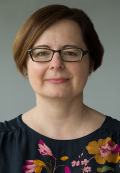Polish for Beginners
Fun and interactive course of Polish language in simple and typical everyday situations.
Fun and interactive course of Polish language in simple and typical everyday situations.
The course „Polish for Beginners” is intended to equip participants with the basic linguistic and communication skills: speaking, listening comprehension, reading comprehension, writing, assuming basic roles and communicating in simple and typical situations requiring communication.
The course is intended for foreigners studying in Poland in the English language, course participants preparing to undertake studies in Polish as well as all those who demonstrate interest in acquiring the basic knowledge of the Polish language, and is available for everyone who wishes to enrol. The basic knowledge of English permitting to understand instructions and comments included in the course is required.
STRUCTURE, CONTENT, OBJECTIVES AND DURATION OF THE COURSE
Module 1. Welcome to the Polish language lesson
Module 2. Let’s get to know each other
Module 3. Polish letters and speech sounds
Module 4. Hi vs. Good morning. Formal and informal dialogues
Module 5. What are you doing on Wednesday at eight?
Module 6. We are having guests!
Module 7. Where am I?
Module 8. My hobby
Module 9. Let’s go for coffee
Module 10. All the best!
EDUCATIONAL OUTCOMES
REQUIREMENTS FOR PASSING THE COURSE
The course consists of ten modules ended with tests (10 tests, 15 points each) and a final test (40 points). In order to pass the course and get a certificate, the participant must obtain at least 50 % out of total points (95 points out of total 190).
AUTHORS OF THE COURSE

Edyta Gałat
Lecturer of Polish as a foreign language, academic teacher. She has been working as a language teacher since 1997, and has been related with the International Centre of Education of the Cracow University of Technology since 2004 as a teacher of general Polish language and specialised courses. She is the author of general Polish language course books (Język polski - Chcę i mogę!, Ćwiczenia i gry doskonalące proces mówienia, level B and C. Podręcznik nauczyciela), specialist language course books (Architektura. Język specjalistyczny. Skrypt dla obcokrajowców na poziomie A2+/B1, as well as Anatomia. Język specjalistyczny. Skrypt dla obcokrajowców na poziomie A2+/B1) and a few games for teaching vocabulary. She is an author of e-learning courses for foreigners available on the CUT Moodle platform.

Agnieszka Kamińska
Teacher of Polish as a foreign language, academic teacher. Graduate of the Jagiellonian University (Polish philology, 2004) and Silesian University (postgraduate studies, Teaching Polish Language and Polish Culture, 2009). Since 2005 she has been working for the International Centre of Education of the Cracow University of Technology as a teacher of general Polish language and specialised courses.

Izabela Kugiel - Abuhasna
Lecturer of Polish as a foreign language, academic teacher. Since 1989 she has been professionally related with the International Centre of Education of the Cracow University of Technology as a teacher of general Polish language and specialised courses. She is the author of specialist language course books for foreigners studying: economy (Wybraliśmy ekonomię. Podręcznik języka ekonomicznego dla obcokrajowców na poziomie A2+/B1) and science (Studiologia. Podręcznik polskiego języka naukowego dla cudzoziemców na poziomie B1), as well as articles in this field. She is an author of e-learning courses available on the CUT Moodle Platform to foreign students preparing for studies in Poland.
TECHNICAL REQUIREMENTS
Participants of the course can use a standard computer set, a smartphone or a tablet with the internet connection. In order to type Polish characters, you must press the Alt button on your keyboard and the letter (e.g. to type "ą" Alt+a, to type "ę" Alt+e).
OTHER INFORMATION
If you need any help, you are most welcome to contact the teachers via email at any time when the course is in progress (polishmooc@gmail.com). You may also check the F.A.Qs. Note, that some of the pictures used in the course have only decorative function and some recordings have no transcript or subtitles. The video presentations introduce the material both in written and spoken form (text and sound). Some exercises have just self-checking function and do not require any typing or filling in.